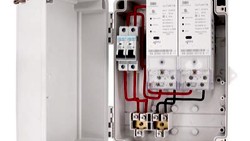The electrical energy sector plays a vital role in powering our economies and daily lives, but it also faces significant sustainability challenges. Traditional "take-make-dispose" linear business models have led to high levels of resource depletion and greenhouse gas emissions across the lifecycles of power generation, transmission and distribution infrastructure. As climate change and resource constraints loom larger, it is clear this linear approach is no longer viable long-term. A transition to a circular economy offers an opportunity to address these challenges through more sustainable resource management.
What is a Circular Economy?
A circular economy is a smart and sustainable approach to economic growth. It focuses on creating positive benefits for society by gradually reducing our dependence on limited resources and minimizing waste. It involves using renewable energy and materials, and keeping products, components, and materials in use for as long as possible. Through practices like durable design, maintenance, repair, reuse, remanufacturing, and recycling, we aim to mimic the efficient cycles found in nature, where waste from one process becomes a valuable resource for another.

(symbol image, credit CLOU)
Benefits of a Circular Economy for the Electrical Energy Sector
Adopting circular economy principles offers significant strategic and operational benefits for electrical energy companies:
- Resource security
Dependence on finite, globally traded resources is reduced through reuse and recycling within technical and biological cycles. This increases resilience against supply and price volatility. - Cost savings
Potential exists across entire supply chains from reuse of parts and materials to efficient, waste-free manufacturing. Refurbishment and remanufacturing can recover significant remaining value from products and infrastructure. - New revenue streams
Circular services around product lifecycle management such as repair, upgrade and take-back open commercial opportunities. Renewable energy sources provide stable, long-term incomes. - Competitive advantage
Forward-looking companies integrating circular strategies gain consumer preference and differentiate their brand versus linear competitors. - Environmental leadership
Closed-loop, waste-free operations and renewable energy deployment help reduce environmental impact, align with regulatory climate goals and build stakeholder trust.
How to Implement a Circular Economy in the Electrical Energy Sector
There are a number of ways that companies in the electrical energy sector can implement a circular economy approach, including:
- Design for circularity
Companies can design their products and services with circularity in mind. This means using materials that can be easily recycled or reused, and designing products that can be easily repaired or upgraded. - Use recycled and renewable materials
Companies can reduce their environmental impact by using recycled and renewable materials in their products and services. - Offer repair and refurbishment services
Companies can help to extend the lifespan of their products by offering repair and refurbishment services. - Take back used products
Companies can take back their used products at the end of their lifespan and recycle or reuse them. - Collaborate with other stakeholders
Companies can work with other stakeholders in the electrical energy sector to develop circular economy solutions.
Overcoming Barriers and Challenges
Transitioning to a circular economy can present certain barriers and challenges for companies in the electrical energy sector. It's important to address these obstacles and offer insights and recommendations on how to overcome them. Some common challenges include:
Financial Constraints
Implementing circular practices may require upfront investments in new technologies, infrastructure, and research and development. Companies can overcome financial constraints by seeking partnerships, accessing funding opportunities, and exploring innovative business models that generate revenue from circular services and products.
Technological Limitations
Some companies may face technological limitations when trying to adopt circular practices. Investing in research and development can help overcome these limitations, fostering innovation and the development of new technologies that enable more efficient resource recovery, recycling, and remanufacturing processes.
Resistance to Change
Resistance to change is a common challenge when transitioning to a circular economy. It's important to foster a culture of innovation and collaboration within the organization, emphasizing the benefits and long-term value of circular practices. Engaging employees, providing training and education, and involving them in the decision-making process can help overcome resistance and create a shared vision for the circular transition.
Regulatory and Policy Environment
Navigating the regulatory and policy landscape can be challenging, as it varies across different regions and jurisdictions. Companies can overcome this challenge by actively participating in policy discussions, advocating for supportive regulations, and collaborating with industry associations and other stakeholders to create a conducive environment for circular practices.
Takeaway
The circular economy offers a more sustainable approach to economic growth. By adopting a circular economy approach, companies in the electrical energy sector can reduce their costs, improve their efficiency, enhance their competitiveness, improve their environmental performance, and increase their resilience. Embracing circularity not only benefits the bottom line but also contributes to a greener and more sustainable future for our planet.
Thank you for reading. If you would like to share your thoughts on this topic, please feel free to leave a comment below. We value your feedback and are always eager to hear from our readers.
Until then, let's keep moving towards a circular future together!






All comments are moderated before being published. Inappropriate or off-topic comments may not be approved.